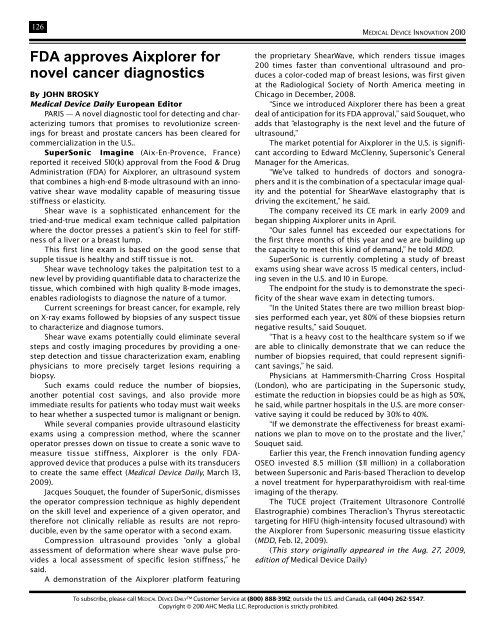MEDICAL DEVICE INNOVATION - Medical Device Daily
MEDICAL DEVICE INNOVATION - Medical Device Daily
MEDICAL DEVICE INNOVATION - Medical Device Daily
You also want an ePaper? Increase the reach of your titles
YUMPU automatically turns print PDFs into web optimized ePapers that Google loves.
126<br />
FDA approves Aixplorer for<br />
novel cancer diagnostics<br />
By JOHN BROSKY<br />
<strong>Medical</strong> <strong>Device</strong> <strong>Daily</strong> European Editor<br />
PARIS — A novel diagnostic tool for detecting and characterizing<br />
tumors that promises to revolutionize screenings<br />
for breast and prostate cancers has been cleared for<br />
commercialization in the U.S..<br />
SuperSonic Imagine (Aix-En-Provence, France)<br />
reported it received 510(k) approval from the Food & Drug<br />
Administration (FDA) for Aixplorer, an ultrasound system<br />
that combines a high-end B-mode ultrasound with an innovative<br />
shear wave modality capable of measuring tissue<br />
stiffness or elasticity.<br />
Shear wave is a sophisticated enhancement for the<br />
tried-and-true medical exam technique called palpitation<br />
where the doctor presses a patient’s skin to feel for stiffness<br />
of a liver or a breast lump.<br />
This first line exam is based on the good sense that<br />
supple tissue is healthy and stiff tissue is not.<br />
Shear wave technology takes the palpitation test to a<br />
new level by providing quantifiable data to characterize the<br />
tissue, which combined with high quality B-mode images,<br />
enables radiologists to diagnose the nature of a tumor.<br />
Current screenings for breast cancer, for example, rely<br />
on X-ray exams followed by biopsies of any suspect tissue<br />
to characterize and diagnose tumors.<br />
Shear wave exams potentially could eliminate several<br />
steps and costly imaging procedures by providing a onestep<br />
detection and tissue characterization exam, enabling<br />
physicians to more precisely target lesions requiring a<br />
biopsy.<br />
Such exams could reduce the number of biopsies,<br />
another potential cost savings, and also provide more<br />
immediate results for patients who today must wait weeks<br />
to hear whether a suspected tumor is malignant or benign.<br />
While several companies provide ultrasound elasticity<br />
exams using a compression method, where the scanner<br />
operator presses down on tissue to create a sonic wave to<br />
measure tissue stiffness, Aixplorer is the only FDAapproved<br />
device that produces a pulse with its transducers<br />
to create the same effect (<strong>Medical</strong> <strong>Device</strong> <strong>Daily</strong>, March 13,<br />
2009).<br />
Jacques Souquet, the founder of SuperSonic, dismisses<br />
the operator compression technique as highly dependent<br />
on the skill level and experience of a given operator, and<br />
therefore not clinically reliable as results are not reproducible,<br />
even by the same operator with a second exam.<br />
Compression ultrasound provides “only a global<br />
assessment of deformation where shear wave pulse provides<br />
a local assessment of specific lesion stiffness,” he<br />
said.<br />
A demonstration of the Aixplorer platform featuring<br />
<strong>MEDICAL</strong> <strong>DEVICE</strong> <strong>INNOVATION</strong> 2010<br />
the proprietary ShearWave, which renders tissue images<br />
200 times faster than conventional ultrasound and produces<br />
a color-coded map of breast lesions, was first given<br />
at the Radiological Society of North America meeting in<br />
Chicago in December, 2008.<br />
“Since we introduced Aixplorer there has been a great<br />
deal of anticipation for its FDA approval,” said Souquet, who<br />
adds that “elastography is the next level and the future of<br />
ultrasound,”<br />
The market potential for Aixplorer in the U.S. is significant<br />
according to Edward McClenny, Supersonic’s General<br />
Manager for the Americas.<br />
“We’ve talked to hundreds of doctors and sonographers<br />
and it is the combination of a spectacular image quality<br />
and the potential for ShearWave elastography that is<br />
driving the excitement,” he said.<br />
The company received its CE mark in early 2009 and<br />
began shipping Aixplorer units in April.<br />
“Our sales funnel has exceeded our expectations for<br />
the first three months of this year and we are building up<br />
the capacity to meet this kind of demand,” he told MDD.<br />
SuperSonic is currently completing a study of breast<br />
exams using shear wave across 15 medical centers, including<br />
seven in the U.S. and 10 in Europe.<br />
The endpoint for the study is to demonstrate the specificity<br />
of the shear wave exam in detecting tumors.<br />
“In the United States there are two million breast biopsies<br />
performed each year, yet 80% of these biopsies return<br />
negative results,” said Souquet.<br />
“That is a heavy cost to the healthcare system so if we<br />
are able to clinically demonstrate that we can reduce the<br />
number of biopsies required, that could represent significant<br />
savings,” he said.<br />
Physicians at Hammersmith-Charring Cross Hospital<br />
(London), who are participating in the Supersonic study,<br />
estimate the reduction in biopsies could be as high as 50%,<br />
he said, while partner hospitals in the U.S. are more conservative<br />
saying it could be reduced by 30% to 40%.<br />
“If we demonstrate the effectiveness for breast examinations<br />
we plan to move on to the prostate and the liver,”<br />
Souquet said.<br />
Earlier this year, the French innovation funding agency<br />
OSEO invested 8.5 million ($11 million) in a collaboration<br />
between Supersonic and Paris-based Theraclion to develop<br />
a novel treatment for hyperparathyroidism with real-time<br />
imaging of the therapy.<br />
The TUCE project (Traitement Ultrasonore Controllé<br />
Elastrographie) combines Theraclion’s Thyrus stereotactic<br />
targeting for HIFU (high-intensity focused ultrasound) with<br />
the Aixplorer from Supersonic measuring tissue elasticity<br />
(MDD, Feb. 12, 2009).<br />
(This story originally appeared in the Aug. 27, 2009,<br />
edition of <strong>Medical</strong> <strong>Device</strong> <strong>Daily</strong>)<br />
To subscribe, please call <strong>MEDICAL</strong> <strong>DEVICE</strong> DAILY Customer Service at (800) 888-3912; outside the U.S. and Canada, call (404) 262-5547.<br />
Copyright © 2010 AHC Media LLC. Reproduction is strictly prohibited.
















